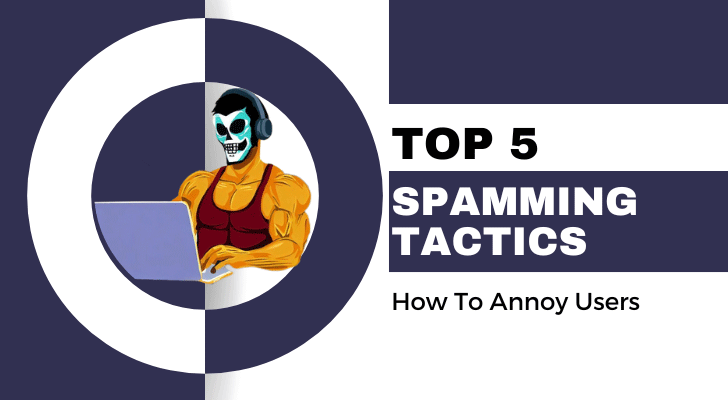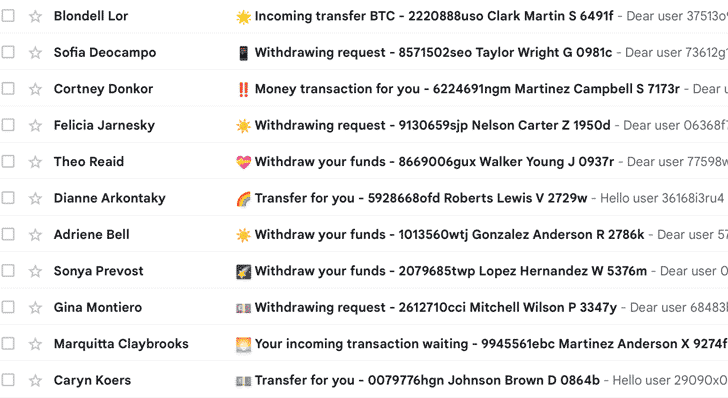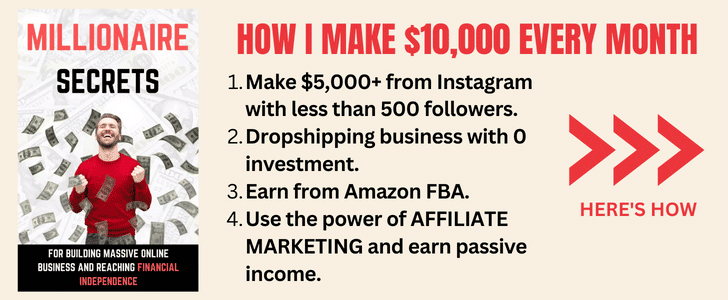Welcome to the wild world of spamming! Just kidding. I'm not here to teach you how to annoy users and bombard their inboxes with unsolicited messages. In fact, quite the opposite.
There are countless opportunities for businesses to engage with consumers. Yet, many newcomers inadvertently adopt spamming tactics without recognizing them as such. They'll draw short-term attention for sure, but often come at the cost of long-term damage to your reputation and credibility.
Spamming, whether intentional or not, is counterproductive. Genuine, thoughtful, and user-centered strategies are always more rewarding in the online marketing space. Newcomers should familiarize themselves with best practices to avoid the pitfalls of spam and cultivate genuine connections with potential customers.

Did You Know?
- 85% of all emails received worldwide are considered spam.
- Around 45% of all email spam is related to advertising bogus products or services.
- Approximately 33% of people report feeling frustrated by the constant influx of spam emails.
- 60% of online users find pop-up advertisements very annoying.
- Over 50% of internet users cite spam emails as the top reason for reduced productivity.
- Around 30% of smartphone users receive unwanted spam text messages at least once a week.
- Nearly 40% of email users have accidentally clicked on a spam link, increasing their frustration.
#1 Email Spam
Imagine signing up for a newsletter from a favorite online store. The expectation might be to receive occasional updates on new products, sales, or special offers. But instead of getting an email once in a while, there's an email waiting in the inbox every single day. In some cases, there might be multiple emails from the same store in a single day.
It's similar to checking a physical mailbox and finding it jam-packed with flyers from the same shop every day. After a short while, even if the content of those flyers is appealing, the sheer volume becomes overwhelming. Amidst the flood of messages, other essential emails can get lost or overlooked.
The excessive number of emails doesn’t just take up space in an inbox. When a person feels bombarded by too many messages from the same sender, they might start to view those messages as annoying or unnecessary. As a result, instead of looking forward to the store's emails, they might begin marking them as spam or unsubscribing entirely.
So, overzealous email campaigns are essentially when a brand sends out too many emails too frequently. Even if the intention is good, like keeping subscribers in the loop, the outcome can be counterproductive.

Email spam
#2 Unsolicited Direct Messages
Imagine being at home and hearing a knock on the door. Opening it, you find a stranger handing out flyers for a product or service you never asked about. It's unexpected and might feel intrusive, right?
That's the online version of unsolicited direct messages.
Not every social network user is fond of receiving direct messages from people that they don't know. Because it's like having a private chat but spammers send promotional messages without any prior interaction.
For example, after following a new fitness page on Instagram, you might receive a direct message saying, "Buy our new workout plan!" You only followed the page, doesn’t mean you wanted further information provided. As a user, you want to contact them in your own good time, right?
This situation can feel a bit awkward. Receiving messages from someone you don't know or haven't interacted with can seem out of place. And if the message is trying to sell something, it might come off as pushy or aggressive.
So, unsolicited direct messages are unexpected messages, often promotional, sent without any prior conversation or connection. They pop up in personal message inboxes, often causing surprise or annoyance.
Did You Know?
- 22% of spam emails trick users by pretending to be from a trustworthy source.
- 48% of users report that spam emails have at least once contained malware.
- 35% of people say that spam makes them feel less trustful of email communications in general.
- Approximately 25% of internet users are concerned about the security risks associated with spam.
- Over 20% of online shoppers have received spam emails related to e-commerce transactions.
- 15% of users find spam in social media messages and comments very intrusive.
- 28% of internet users report an increase in spam emails after signing up for online services or newsletters.
#3 Commenting With Links

Imagine you're at a gathering, having a chat about your favorite movies. Suddenly, someone you don't know interrupts to promote their own business, handing out flyers. That's unexpected and a bit off-topic, right?
This is similar to what happens online with "commenting with links."
On the internet, there are many spaces like blogs, forums, and social media posts where people can leave comments. It's a spot for sharing thoughts and reactions or adding to the discussion. But sometimes, someone will drop a link to their website or product right in the middle of these comments. It's as if they've suddenly changed the topic to talk about their own thing.
For instance, in the comment section under a product review article, people often comment,
“This is a great article. You should also check out my XYZ review because this is an awesome product! Here is the link.”
They’re not commenting anything about the product review, and the link they pasted is totally irrelevant.
Spammers also do that so casually on social media, and other users never like this because it feels out of place. It's like someone trying to steal the spotlight. Plus, many online platforms and groups don't like this behavior. They might see it as spammy or disruptive. So, those who frequently comment with unrelated links might find themselves blocked or banned from that platform or group.
In short, commenting with links is when someone leaves a link to their own stuff in a discussion where it doesn't belong, often causing annoyance or breaking the flow of the original conversation.
Did You Know?
- About 18% of spam is crafted to phish for personal information, leading to heightened user annoyance and concern.
- 34% of users have reported spam to their email providers or authorities.
- Nearly 10% of internet users have stopped using an email address because of excessive spam.
- 43% of users find spam comments on blog posts and articles bothersome.
- 29% of people are irritated by unsolicited promotions and offers on social media platforms.
- 21% of users have installed ad blockers primarily to avoid spam and intrusive ads online.
- 17% of mobile users are annoyed by spam calls that interrupt their daily activities.
#4 Buying Followers/Likes
Imagine you're at a party. You see someone surrounded by a big crowd, laughing and chatting. At first glance, it seems like this person is super popular. But then you notice something odd. Most of the people around them are just standing there, not really interacting or even looking at the person. Turns out, they paid these people to stand around and pretend to be their friends.
That's a bit like buying followers or likes on social media.
On platforms like Instagram or Twitter, the number of followers or likes can sometimes be seen as a sign of popularity or success. Because of this, some people might pay money to get extra followers or likes, hoping it makes them look more impressive.
For example, a new music artist might buy 10,000 followers on their profile. At first glance, it seems like they're super popular. But when they post a song, it gets only a handful of real interactions.
There's a catch, though. These bought followers and likes aren't genuine. They're often just fake accounts or bots, not real people who care about the content. And because they're not real, they don't really engage or interact in a meaningful way.
Social media platforms notice this too. They can often tell when followers or likes are fake, and they don't like it. They want genuine interactions on their platforms. So, they're taking steps against this, and accounts caught buying followers or likes might face penalties.
To sum it up, buying followers or likes is like paying for pretend popularity on social media. It might look good at first, but it lacks real interaction and can have consequences.
#5 Auto-Play Videos with Sound

Auto-play videos that have sound are pretty annoying, right?
When you click on a website, you might be expecting to read an article or look at some pictures. But sometimes, as the site loads, a video starts playing automatically with a loud sound. It's like that surprise radio blast — you didn't turn it on, but there it is, demanding your attention.
For example, you might click on a site to read about a new type of plant. As the page opens, a video about gardening tools begins playing with sound, even though you didn't click on it. The sudden noise can be startling, especially if your computer or phone volume is high.
This can be a problem for several reasons. For one, it might disrupt what you're doing, especially if you're in a quiet place or listening to your own music. Plus, if you're using mobile data, videos can eat up a lot of it without you choosing to watch them.
So, in simple terms, auto-play videos with sound are like unexpected, loud interruptions when you're trying to do something else online. They start on their own, often surprising and annoying users.
Other Spamming Tactics
- Pop-ups on Website Entry: Pop-up ads or sign-up forms that appear the moment a user lands on a webpage can be intrusive. Visitors want to see content first before deciding to engage further, and immediate pop-ups can deter them.
- Link Farming: This refers to creating networks of websites that link to each other for the sole purpose of increasing search engine ranking. It's a black-hat SEO technique that, once detected, can lead to serious penalties.
- Duplicate Content: Reposting the same content across various platforms or sites without tailoring can come across as lazy and spam-like. Additionally, search engines might penalize for duplicate content.
How Do You Know You May Be Spamming?
Spamming isn't just sending out lots of emails. It can take many shapes and forms, especially in the world of online marketing. Here are some signs that might hint you're going down the spam path.
Too Much, Too Soon
You've just started a new online store, and you're excited. So, you send out five emails in one day to tell everyone. But think about it. If you get multiple messages from the same place in a short time, it feels like too much. If you're sending a lot of messages in a short time, that could be a sign.
Unwanted Surprises
Imagine going to a party and a stranger keeps giving you flyers. You didn't ask for them, but they keep handing them to you anyway. This is similar to sending messages to people who didn't ask for them. If you're reaching out to people who haven't shown interest in what you offer, it might be spam.
Links Everywhere
You're having a chat online about a new movie. Suddenly, someone drops a link promoting their business. It feels out of place, right? If you're always dropping links everywhere, especially where they don't fit the conversation, it might be a spam sign.
Too Good To Be True
Your social media account has 10,000 followers, but only a few likes or comments? That's odd. Sometimes people try to look popular by buying followers. But these aren't real fans, they're just numbers. If there's a big difference between your followers and real interactions, that's a hint.
Loud Interruptions
You're browsing a website, and suddenly a loud video starts playing. You jump in surprise. Videos that play on their own, especially with sound, can feel like someone shouting at you without warning. If your website has these surprise videos, it might feel spammy to visitors.
What People Say
Feedback is a mirror. If many people are saying they feel spammed, or if you're getting a lot of complaints, that's a clear signal. Listen to what they're saying. It can give you a clear picture of how you come across.
Platform Penalties
Online platforms want good content. If you're getting warnings or even bans from platforms, that's a strong sign. These platforms have rules to keep content useful and enjoyable for users. Breaking those rules too often can get you flagged as spam.
Reading the Signs
So, how do you know if you're spamming? It's all about paying attention. If you see these signs, take a step back. Ask yourself how you'd feel if you were on the receiving end. Would you be happy or annoyed? By looking for these signs and asking these questions, you can get a clearer picture of where you stand.

Author Bio: Zooper
As a magician and mindreader, I have dedicated my life to spreading positivity to the world. Reality may be an illusion, but that doesn't mean happiness is. Open yourself to the extraordinary hidden within it, and watch your joy take flight. This is the truth I'm on a mission to share.



Another blog post pushing digital marketing? Most of these so-called ‘tips’ are just unrealistic for beginners. It’s not easy to make money unless you’re already an expert. Feels misleading to me.
Thanks for your comment, that sounds great! Keep chasing unrealistic dreams. Wish you all the guru best!